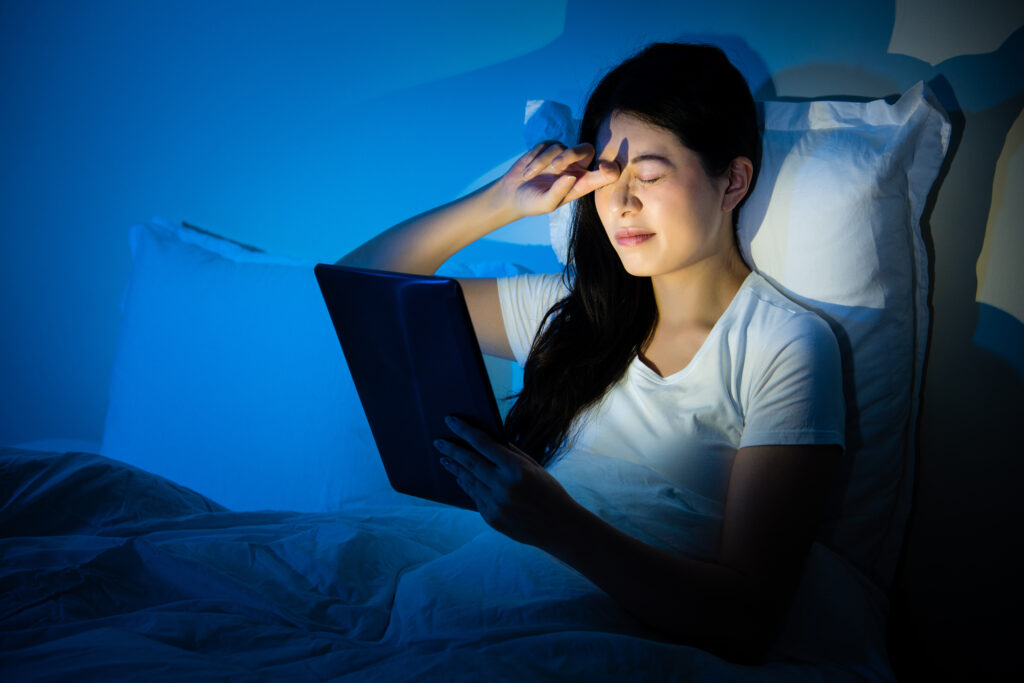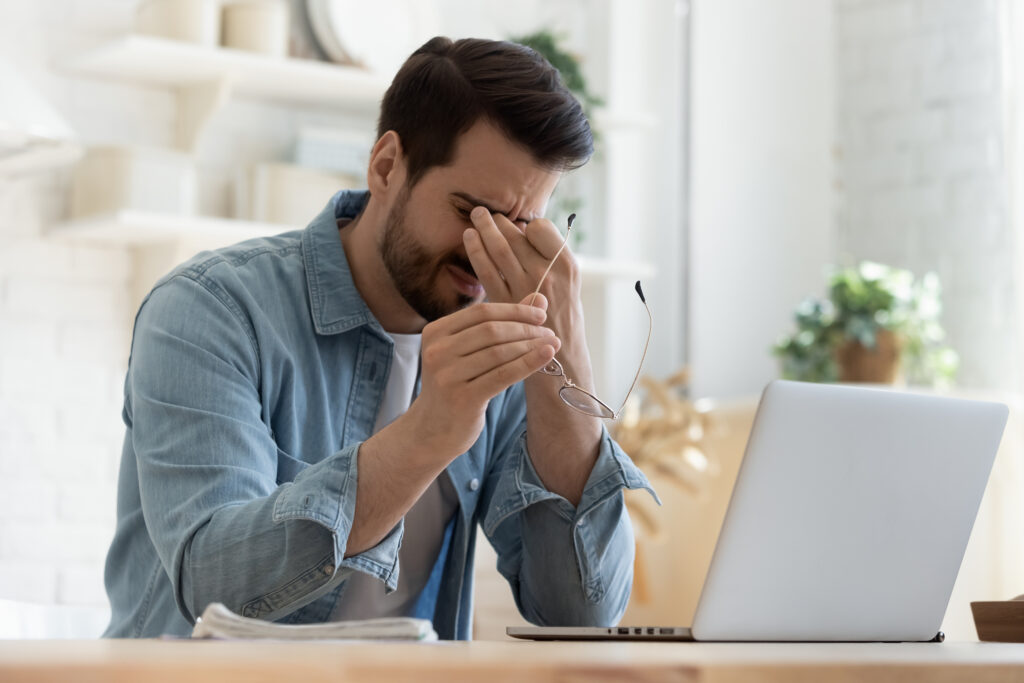ARTICLE
Ergonomy
Looking at screens : their effects on the eyes
FOREWORD
Teleworking brings its share of advantages for workers. However, it also contributes to an increase in the amount of time spent working in front of screens.
To compensate, workers are developing new habits to reduce eye strain. Some use glasses to reduce exposure to blue light. Others position the screens further away from their eyes to avoid the development of visual disorders such as myopia.
Are these new practices to be recommended? To answer the question, we looked at the various studies on the subject.
According to information reported in the media, blue light from screens could damage the eyes. However, the American Academy of Ophthalmology (AAO) reassures us and warns us that this shared claim is unfounded. The study to which the media referred is not representative of what actually happens in our cells when we look at a screen. There is therefore no scientific evidence of permanent effects on the eyes caused by blue light from screens. In addition, we would be more exposed to blue light with natural lighting (O’hagan et al., 2016)¹”. We therefore should not have to worry about the blue light from our screens, except, perhaps, before going to bed. Indeed, the study by Chang et al. (2015)»2» shows that using electronic devices in the hours before going to bed increases the time needed to fall asleep and reduces the level of alertness the following morning. Like natural light, the light from our screens keeps us awake. It should therefore be limited in the evening so as not to disrupt our circadian rhythms.

Regarding the effectiveness of blue light blocking glasses, current studies do not show significant results (Sheppard and Wolffsohn, 2018“3”; Singh et al., 2021“4”). In the study by Leung et al. (2017)»5», the majority of participants were not even able to perceive the changes generated by the blue light filter lenses.
Although a screen too close to you can be demanding on the eyes, there is no scientific evidence between the distance of the screens and the development of myopia. In fact, adult vision is relatively stable up to the age of 40. However, not spending enough time outdoors is thought to have an impact on the development of vision in children, adolescents and even young adults. Exposure to sunlight is thought to have a protective effect against myopia during the development of vision (Williams et al., 2017) 6.
It is recognized that working in front of a screen can cause eyestrain. This is due to the sustained effort of the eyes to fixate on an object for long periods of time (Anshel, 2007) “7” and to the decrease in the number of blinks. In fact, in the study by Tsubota and Nakamori (1993) 8, the number of blinks per minute goes from 22 in relaxing conditions, to 10 while reading a book and to 7 while reading on a screen. In the study by Cardona et al. (2011) 9, the number of blinks and the amplitude of the blinks are reduced when the participants must perform a task in front of a screen. Moreover, the reduction is greater when there is more information to process. In other words, when we are absorbed in our work, staring at the screen, our eyes become tired from remaining focused at the same distance and from being open for longer.
Moreover, poor positioning of the screen contributes to increased eye strain, since when the screen is too high, the eyes must be opened wider, which further increases the evaporation of tears (Tsubota and Nakamori, 1995) “10”. The eyes then feel drier. Another cause of visual fatigue is the failure to use appropriate optical correction, as the eye muscles work harder and get tired more quickly.

In addition to diligently taking visual exams and positioning screens optimally, adopting certain habits can help prevent the onset of visual fatigue.
Among these practices, Anshel’s popular 20-20-20 rule remains the most recommended: every 20 minutes, look at a point 20 feet (6 meters) away for 20 seconds. By looking into the distance, we give our eye muscles a break. The beneficial effects of visual breaks are well documented. In the study by Reddy et al. (2013)¹¹, students who took the time to look into the distance regularly while looking at their screen felt less eye strain. In addition, in the study by Galinsky et al. (2007)¹², additional five-minute breaks per hour had a positive impact on the eye strain felt by the participants and their productivity. It is therefore beneficial to give our eyes regular breaks. However, it is important not to forget to take them. To help you remember, applications such as EyeLeo allow you to set reminders on your computer.
To move towards a more natural blinking rate, the AAO and Anshel (2005) recommend blinking voluntarily on a regular basis. In the study by Kim et al. (2021), performing short routines of eye-blinking exercises every 20 minutes helped participants increase their number of blinks in front of a screen.
- Look away from the screen for a few seconds
- Look around
- Focus on distant objects
- Blink a few times
Working in front of a screen is not a problem in itself; rather, it is the misuse of screens that can create non-permanent visual discomfort.
So don’t wait to get into these good habits:
- Lower your screens if they are too high;
- Take regular visual breaks by looking into the distance (20-20-20);
- Blink your eyes deliberately to achieve a more natural blinking rate.
Our references
1-O’hagan, J. B., Khazova, M., & Price, L. L. A. (2016). Low-energy light bulbs, computers, tablets and the blue light hazard. Eye, 30(2), 230-233.
2-Chang, A. M., Aeschbach, D., Duffy, J. F., & Czeisler, C. A. (2015). Evening use of light-emitting eReaders negatively affects sleep, circadian timing, and next-morning alertness. Proceedings of the National Academy of Sciences, 112(4), 1232-1237.
3-Sheppard, A. L., & Wolffsohn, J. S. (2018). Digital eye strain: prevalence, measurement and amelioration. BMJ open ophthalmology, 3(1), e000146.
4-Singh, S., Downie, L. E., & Anderson, A. J. (2021). Do Blue-blocking Lenses Reduce Eye Strain From Extended Screen Time? A Double-Masked Randomized Controlled Trial. American Journal of Ophthalmology, 226, 243-251.
5-Leung, T. W., Li, R. W. H., & Kee, C. S. (2017). Blue-light filtering spectacle lenses: optical and clinical performances. PloSone, 12(1), e0169114.
6-Williams, K. M., Bentham, G. C., Young, I. S., McGinty, A., McKay, G. J., Hogg, R., … & Fletcher, A. E. (2017). Association between myopia, ultraviolet B radiation exposure, serum vitamin D concentrations, and genetic polymorphisms in vitamin D metabolic pathways in a multicountry European study. JAMA ophthalmology, 135(1), 47-53.
7-Anshel, J. R. (2007). Visual ergonomics in the workplace. Aaohn Journal, 55(10), 414-420.
8-Tsubota, K. and Nakamori, K. Dry eyes and video display terminals, New England Journal of Medicine, 328, 8, 1993.
9-Cardona, G., García, C., Serés, C., Vilaseca, M., & Gispets, J. (2011). Blink rate, blink amplitude, and tear film integrity during dynamic visual display terminal tasks. Current eye research, 36(3), 190-197.
10-Tsubota, K., & Nakamori, K. (1995). Effects of ocular surface area and blink rate on tear dynamics. Archives of ophthalmology, 113(2), 155-158.
11-Reddy, S. C., Low, C. K., Lim, Y. P., Low, L. L., Mardina, F., & Nursaleha, M. P. (2013). Computer vision syndrome: a study of knowledge and practices in university students. Nepalese journal of Ophthalmology, 5(2), 161-168.
12-Galinsky, T., Swanson, N., Sauter, S., Dunkin, R., Hurrell, J., & Schleifer, L. (2007). Supplementary breaks and stretching exercises for data entry operators: A follow‐up field study. American journal of industrial medicine, 50(7), 519-527.
13-Anshel, J. (Ed.). (2005). Visual ergonomics handbook. CRC Press.
14-Kim, A. D., Muntz, A., Lee, J., Wang, M. T. M., & Craig, J. P. (2021). Therapeutic benefits of blinking exercises in dry eye disease. Contact Lens and Anterior Eye, 44(3), 101329.
